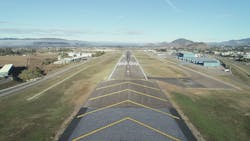The San Luis Obispo County Regional Airport (SBP) completed its Runway 11-29 Rehabilitation Project October of 2021. It’s the first significant rehabilitation of the runway since 1997, which prior had been extended twice – most recently in 2007.
“The joint separations, we had a lot of longitudinal cracking going on in sections there. And really, a large portion of the runway had not received much attention for quite some time,” said Craig Piper, deputy director, Department of Airports, County of San Luis Obispo.
“The driving factor on it was that the runway was showing significant signs of deterioration due to the age of the asphalt surface. We determined the runway was structurally fine, it was just that the surface was starting to deteriorate,” added Scott Van Gompel, department manager, aviation, Mead & Hunt.
At the same time, the runway lighting was found to be beyond its useful lifespan and the spacing no longer compliant to FAA standards.
“The project included the full replacement of that existing infrastructure, as well as a mill and overlay of the surface of the runway to get a new surface on top,” said Van Gompel.
What made the project unique was its use of Construction Manager at Risk (CMAR), a move not often taken with projects of this nature.
“We start working as a contractor with a designer in the airport. In this case, at the 60% plan level, we were brought in to start analyzing plans and specs and value engineering type work and cost analysis,” described Adam Souza, construction manager, Granite Construction.
“Then when it comes down to the 100% plan phase, we put together a price, a GMP price, which is called guaranteed maximum price. We sat down with the owner and the engineer and reviewed it and agreed upon that it was fair. And we were awarded the contract to do the construction phase. Whereas a traditional project, a bid-build project, plans are put out. You have plus or minus 30 days to put together a price, and you turn it in. At that point, the contractor has no input in how to make the project better at that point,” Souza continued.
Piper said it is the county’s first CMAR project.
“I believe it's the first one that has been done at least in California, under AIP grant,” Piper added.
Phased for Success
CMAR was crucial to the success of the project, especially when it came to phasing the work and minimizing the constructions impacts to the airlines’ and airport’s operations.
“We have a single runway that the air carriers use. The phasing and the logistics of this project was the key piece of why we decided to go with CMAR, because we needed to have that contractor in as part of the design process and work through that, because we needed to work around the airline flight scheduled.
“We need to understand what kind of impact that was going to be to the airlines. How long is this project going to take? How much do we need to close the runway down, because we're doing the entire runway. Do we just rip the Band-Aid off and we're closed for six weeks entirely? Or do we do some modified version of that?” Piper said.
Four phasing alternatives were conceived of by engineer and CMAR team – Mead & Hunt and Granite – including a full airport closure that would span two weeks. The plans were then presented to the airlines and other stakeholders at the airport and flying public.
“Ultimately what we developed was a hybrid phasing schedule that included a 48-hour full closure of the airport to begin the project in July, that was our first task, was to close the airport for two days and go and do the paving work that had to occur during that window at the end of the runway,” Van Gompel said.
That was followed by a 21-day, 12-hour closure. And lastly, after that period, there was a final 48-hour closure to finish off the paving at the runway end again.
“The schedule was very challenging, but it was also very well developed and there were no impacts to the scheduled airline operations,” Van Gompel said.
“The biggest thing for Granite was really these 48-hour closures. We worked around the clock for two days straight. That just takes a lot of resources from everybody, from Granite internally, subcontractors, asphalt suppliers. Everybody's got their own logistics to work out when you're going continuous for 48 hours. So logistically, that was a challenge for us. We succeeded. We finished the work we needed to within the 48-hour window. So that was a big win for everybody,” added Souza.
New Runway, New Lights
Souza said that four inches was milled off from most of the runway and replaced with new asphalt. On the east and west ends of the runway, there were grade changes, requiring two inches to be milled off and replaced with six inches of new asphalt.
“In a nutshell for 90% of the runway was to take off four inches and put four inches of asphalt back. So, we milled off four inches nightly and paved it back in a 2-inch lift staggering out joints,” he continued.
As they milled off the runway, Piper said soft spots were discovered, resulting in sections of the runway needing to be reinforced.
“We had some pumping starting to happen. And so, they actually had to mill the rest of that off, take up some soil and then put down and re-compact, and then rebuild that and in a small section, but those were not significant obstacles,” he said.
On the lighting side, went from incandescent to LED runway lighting.
“We replaced our entire runway circuit and all the fixtures, all the isolation transformers, there was new conduit place. So we trenched in new conduit, new cans. In certain locations, we had to re-utilize the crossing points under our connector taxiways,” Piper said. “We ended up with the all new runway lights. They pulled all new conductors from the home run all the way from the vault, where our constant current regulator is, all the way out and replaced all the conductors out there, around the runway.”
Altogether, the work came to roughly $13.4 million, and Piper they came in slightly under budget. Ultimately, attributed the success of the project to their use of CMAR.
“Using CMAR, when you have a level of complexity, at least from my perspective, that we did from the logistics on the phasing standpoint, that was key to having CMAR on board, having the contractor on board through the design phase. I think that was really key to really help us phase the project in the way that they could accomplish the work. And we can still keep the runway operational. It was a key component of allowing us to get this done and having it go so smoothly,” said Piper.
“I would just really echo the CMAR process,” added Souza. “All airports have really tight scheduling issues with all the operations going on. Bringing a contractor on board early and being able to vet all the options and really pick the best one for each airport I think is a big advantage.”
About the Author
Walker Jaroch
Editor
Contact: Walker Jaroch
Editor | AMT
+1-920-568-8399
>> To download the AviationPros media kits, visit: Marketing Resource Center
>>Check out our aviation magazines: Ground Support Worldwide | Airport Business | Aircraft Maintenance Technology

